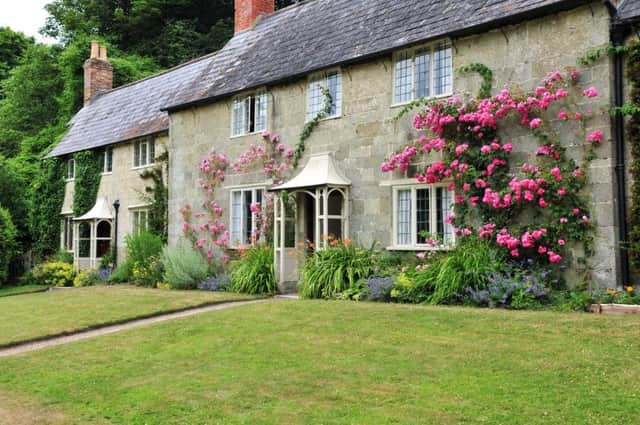Listed Property Show comes to town


These sort of issues led to the birth of The Listed Property Owners Club, which offers help and advice. The club has joined forces with Historic England to go “on the road” and its first stop is at the Harrogate International Centre today, March 12, and tomorrow.
There will be local suppliers and specialists, along with conservation officers and architects. The Listed Property show also has lectures and demonstrations Tickets are free to download from www.lpoc.co.uk/property-show.
Advertisement
Hide AdAdvertisement
Hide AdHere, the show’s experts, including conservation officer Peter Bell, offer some answers to common questions:
Q. How do I know if my building is a listed building?
A. You can check if your building is listed by referring to the Historic England website or by contacting the Listed Property Owners Club at www.lpoc.co.uk.
Q. What is protected by listing? Is it just the front elevation?
A. No. When a building is listed, the inside and outside are protected. In fact, listing extends to the whole of the building, to anything attached to the building, such as a garden wall, and to any building within the curtilage built before 1948. The statutory penalties for carrying out work without consent can be quite severe so it is always worth checking with your local planning authority.
Advertisement
Hide AdAdvertisement
Hide AdQ. What type of alterations require listed building consent?
A. The law requires that all alterations that affect the character of a listed building require listed building consent from the local planning authority. Decoration and changing the kitchen or bathroom fittings are not normally considered as alterations but for anything more substantial it is worth seeking advice before proceeding. Beware the builder who says that an alteration does not require consent because he will be long gone when the enforcement officer calls.
Q. Do repairs require listed building consent?
A. Some repairs, if carried out carefully by a competent craftsman, do not require listed building consent. An example would be repointing stonework; sensitive repointing using appropriate materials would not affect character and so would not require consent, whereas cement ribbon pointing would be very damaging and so would require consent.
Q. What if a previous owner made alterations without consent?
Advertisement
Hide AdAdvertisement
Hide AdA. There is no time limit on listed building enforcement action so new owners can be required to reverse damaging alterations made by previous owners. Consequently, it is important to take proper advice at the point of purchase in order to minimise the risks.
Q. Is it necessary to get special listed buildings insurance?
A. There are very particular issues involved in estimating rebuilding costs for listed buildings should the worst happen. Some companies inflate the cost of policies because they are unfamiliar with the issues. You may also want to consider insuring against the possible consequences of enforcement action if you think a previous owner may have made alterations without consent. The Listed Property Owners Club is able to give free and confidential advice on insurance matters.
Q: Should I consider using reclaimed bricks on my building restoration project?
Advertisement
Hide AdAdvertisement
Hide AdA: Unless absolutely necessary, reclaimed bricks should be avoided. In most cases, reclaimed bricks come from an unknown source, so could include internal wall bricks, which generally, are not fired to be durable to weathering. Reclaimed bricks are not tested for frost resistance or soluble salt content, whereas new bricks made bespoke for your project go through a rigorous process of testing. Evidence of dormant dry rot spores in old bricks coming back to life has come to light recently.
Q: What’s the difference between lime putty, hydraulic lime and hydrated lime?
A: Non-hydraulic lime is sold as either hydrated lime or putty lime. They set and harden through drying out and absorbing carbon dioxide from the air. This means they have a very slow set: CO2 is only absorbed when certain conditions are met. They are the softest, most breathable limes available. Hydrated lime simply means that a controlled amount of water is added to quicklime to make a powder that is more stable and safe to handle. This can be done to hydraulic lime or non-hydraulic lime. Lime putty can be made from either type of lime, and is made by adding an excess of water to quicklime. Hydraulic lime putty will set underwater within hours or days making them impractical, whereas non-hydraulic lime putty will remain plastic and improve with age.
Q: Do conservation officers allow double glazing in listed buildings?
Advertisement
Hide AdAdvertisement
Hide AdA: It all depends on the condition and significance of the existing windows. Sometimes they are allowed, thought if the single glazed windows have to be retained they can be restored
Q: Can waterproof membranes be harmful to listed buildings?
A: Inserting a waterproof membrane of any description in any traditional wall, floor or roof will prevent the building from breathing and result in concentrations of moisture. Traditional solid wall buildings were constructed of permeable materials which absorb moisture when the weather is wet or humid and give it out by evaporation when it is dry. This is referred to as breathable construction. Methods used in modern building constructions such as damp proof membranes, vapor barriers and any impervious layers should be avoided.